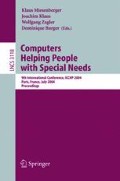Abstract
In this paper, we introduce the concept of “user policies”. The objective of policies is to specify user preferences in terms of presentation and interaction with information. Using this concept, the presentation/interaction with information will be adapted to user’s needs, making information more accessible. We define several kinds of policies (navigation, exploration, presentation, etc.). The concepts of “presentation policies” and “navigation policies” are studied in this article. As XML is the standard for encoding electronic information, we will apply the concept of policies to the browsing of XML Documents.
Access this chapter
Tax calculation will be finalised at checkout
Purchases are for personal use only
Preview
Unable to display preview. Download preview PDF.
References
Web Accessibility Initiative W3C, http://www.w3.org/WAI/
Alternative Web Browsing, Browsers specifically designed for people with disabilities. W3C - Web Accessibility Initiative, http://www.w3.org/WAI/References/Browsing.html#1
Brusilovsky, P.: Adaptive hypermedia: the state of the art. In: Proc.of MHVR 1994 Multimedia, Hypermedia and Virtual Reality, Moscow, September 14-16, pp. 24–29. ICSTI (1994)
Brusilovsky, P.: Adaptive hypermedia User Modeling and User-Adapted Interaction, vol. 11(1-2), pp. 87–110. Kluwer Academic Publishers, Dordrecht (2001), http://ipsapp008.kluweronline.com/content/getfile/5219/12/3/fulltext.pdf
Fink, J., Kobsa, A., Nill, A.: Adaptable and Adaptive Information. Provision for All Users, Including Disabled and Elderly People. The New Review of Hypermedia and Multimedia 4, 163–188 (1998), http://www.ics.uci.edu/kobsa/papers/1998-NRHM-kobsa.pdf
W3C, Extensible Markup Language (XML) 1.0 (Second Edition), http://www.w3.org/TR/REC-xml
DAISY 3, ANSI/NISO Z39.86-2002 standard, http://www.niso.org/standards/resources/Z39-86-2002.html
W3C, Synchronized Multimedia Integration Language (SMIL 2.0), http://www.w3.org/TR/smil20/
XML Path Language (XPath), http://www.w3.org/TR/xpath
W3C, XSL Transformations (XSLT) Version 1.0, http://www.w3.org/TR/xslt
Sun Microsystems, Inc., Java Speech API Markup Language Specification, http://java.sun.com/products/java-media/speech/forDevelopers/JSML/
Author information
Authors and Affiliations
Editor information
Editors and Affiliations
Rights and permissions
Copyright information
© 2004 Springer-Verlag Berlin Heidelberg
About this paper
Cite this paper
Encelle, B., Baptiste-Jessel, N. (2004). Adapting Presentation and Interaction with XML Documents to User Preferences. In: Miesenberger, K., Klaus, J., Zagler, W.L., Burger, D. (eds) Computers Helping People with Special Needs. ICCHP 2004. Lecture Notes in Computer Science, vol 3118. Springer, Berlin, Heidelberg. https://doi.org/10.1007/978-3-540-27817-7_21
Download citation
DOI: https://doi.org/10.1007/978-3-540-27817-7_21
Publisher Name: Springer, Berlin, Heidelberg
Print ISBN: 978-3-540-22334-4
Online ISBN: 978-3-540-27817-7
eBook Packages: Springer Book Archive

